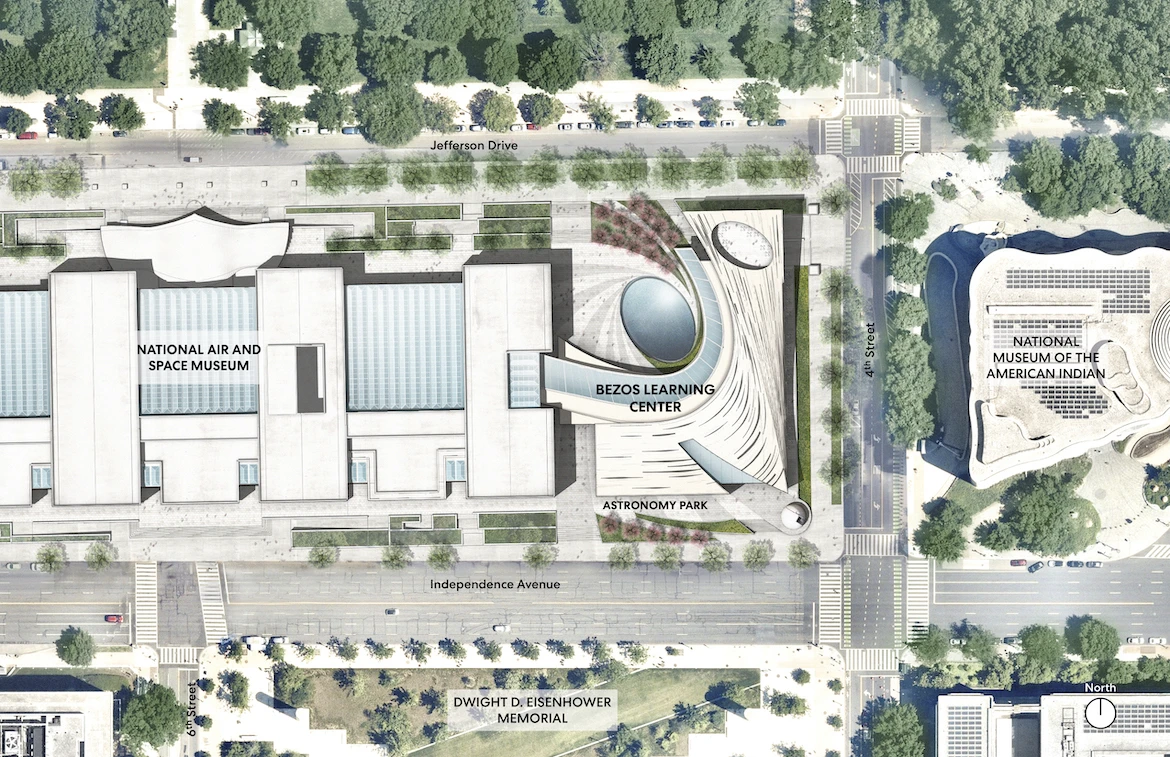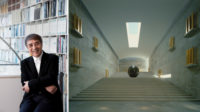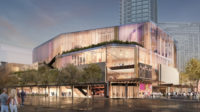The Smithsonian Institution yesterday announced the selection of Perkins&Will to design a $130 million STEAM education center named after Amazon founder and occasional space traveler Jeff Bezos at the National Air and Space Museum in Washington, D.C.
Perkins&Will’s winning concept for the 50,000-square-foot facility, which lead designer Ralph Johnson said draws creative inspiration from the spiral galaxy and its “infinite possibilities,” was selected from a shortlist of five proposals publicly released last September. The proposals for the Bezos Learning Center, all eyebrow-raising to various degrees, attracted a fair amount of attention when unveiled; the fact that each competing firm remained anonymous during the public feedback period added intrigue to the coveted commission. A total of 23 design teams responded to a Request for Qualifications in early 2022, including eventual finalist Perkins&Will (previously only identified as “Firm D”).
Perkins&Will is also one of five finalist teams selected for a competition seeking ideas for a new National Museum of the U.S. Navy in D.C. alongside BIG, Gehry Partners, DLR Group, and Quinn Evans.
The Smithsonian said that Perkins&Will’s prowess in designing museums and educational facilities played a major role in its selection as did the firm’s experience in integrating food service facilities and sustainable design strategies into such projects. Joining Johnson on the design team are designer Tom Mozina, managing principal Bridget Lesniak, project principal Zena Howard, and Aimee Eckman, an education programming and planning specialist with the firm.
Set to include ample dedicated space for educational programming and activities, a public observatory, and a new restaurant, the Bezos Learning Center will rise on the eastern edge of the museum’s National Mall–adjacent campus in the space where Gyo Obata’s pyramidal, glass-clad Wright Place food court pavilion, completed in 1988, once stood before it was demolished last year to make way for the Bezos-branded new addition. (The long-shuttered pavilion’s closure predated the pandemic by several years.)
In an announcement, Perkins&Will described the center as a place where visitors can universe and aviation through multi-day experiences in non-traditional classrooms, collaboration hubs, and a studio—all of which support immersive STEAM learning.” The Smithsonian noted in its own announcement plans for “innovative community partnerships” to bring both local and national students and educators to the center, with a focus on young visitors from underserved communities.

Proposed site map. Image courtesy Perkins&Will
“This is an exceptional opportunity to create a place that unlocks the potential of a new generation of explorers,” said Lesniak. The Bezos Learning Center is also tapping the talents of a new generation of architects well before its opening through the museum’s so-called Student Architecture & Design Challenge, a program offering design students and early-career architects the chance to work with Perkins&Will to “create an architectural element for the future building’s exterior that conceptualizes scientific aviation, astronomy, or aerospace.” A winning team participating in the in-progress competition will be announced later this year at which point they’ll be invited to formally join the Bezos Learning Center project team.
The design and construction of the Bezos Learning Center is funded in part by a $200 million 2021 gift to the National Air and Space Museum from Bezos, who stipulated that $70 million of the total sum go toward intensive renovations throughout the larger HOK-designed museum complex, which first opened in 1976 and today ranks as one of the most visited museums in the world and the largest of the Smithsonian’s 19 museums.The Udvar-Hazy Center, an annex location ;also designed by HOK, opened at Washington Dulles International Airport in 2003.
.jpg?1686025485)





Post a comment to this article
Report Abusive Comment